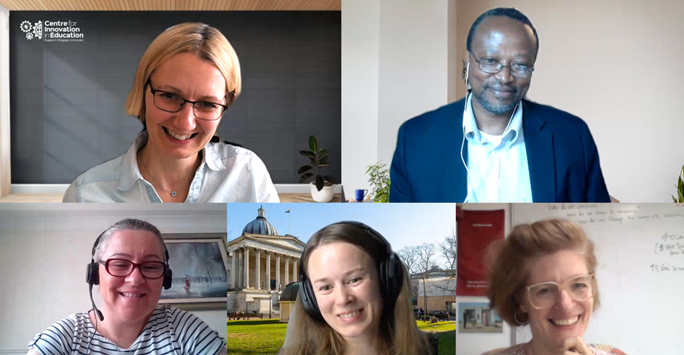Treasure Island Pedagogies: Episode 10 - the one with the cookbooks
Posted on: 29 September 2021 by Dr Tunde Varga-Atkins in General

In Episode 10, in addition to lightbulb moments, treasure island pedagogies/props and luxury items, our discussion touched on various creative collaborative solving approaches with students with our luxury items making sure we will have a great time on the Treasure Island.
Speakers: Emily Chapman-Waterhouse, Emma Davenport, Dr Gulnaz Aksenova and Charles Wachira
Date: 06 September 2021
Treasure Island Pedagogies: Episode 10 podcast
(Treasure Island Pedagogies Episode 10 - Podcast Transcript)
Read or listen to find out our guests’ lightbulb moments, teaching props, pedagogies and luxury items that they would take to their Treasure Islands for precious contact time with students.
Emily Chapman-Waterhouse
Harper Adams University, UK
- Original discipline & current role: equine and human sports sciences, now postgraduate veterinary sciences as well as teaching and learning at Harper Adams University. I started the role of Associate Head of Department (Animal Health, Behaviour & Welfare: Veterinary Nursing) in August this year.
- Lightbulb moment: the joyful moment of reading a new piece of reflective writing, the draft plans and small-scale project protocols of my postgraduate Veterinary students: it was visible that they knew where they were going in their creation of assessed work.
- Teaching prop or pedagogy: I have been trying out a few free hand-drawing tools such as using the whiteboard tool in Teams with my Apple pencil and also encouraging students to do the same. I would also like to bring online noticeboards (e.g. Padlet) that capture student feedback in a more relaxed, anonymous manner, as a sort of pulse survey, to get a sense of their progress.
- Luxury item: cup of tea and a generous bar of chocolate!
Emma Davenport
London Metropolitan University, UK
- Original disciplinary background: education, anthropology and design history
- Current role: Academic mentor, Senior Lecturer in Art and Design and Head of Student Experience and Academic Outcomes for the School of Architecture, Art and Design, London Metropolitan University
- Lightbulb moment for two scenarios:
- Pre-lockdown: art and design students find certain modules we teach around critical and contextual studies challenging because of their focus on text and abstract thinking. So I decided to bring objects to my lectures to use during my presentation and asking students to consider what they would do with them, how they would relate it to the topics covered. It really changed the atmosphere and was brilliant for getting discussion going.
- During Covid: the challenge during lockdown and online learning was making a 2D/virtual experience more interactive for students. Students really want to connect with your 3D-self and you have to work harder at it to convey the ‘you’. I have found that sharing something about yourself that you can’t see otherwise from the screen can really help bring you, and so the material, into the teaching space.
- Teaching prop or pedagogy: it would be stationery, pens, post-its, paper! I still like using notebooks for drawing out ideas. We don’t always have to be doing Powerpoint presentations – but step back and think about learning as a dialogue. Materials things can help with this process.
- Luxury item: a selection of cookbooks as I find reading recipes really relaxing.
Dr Gulnaz Aksenova
UCL, UK
- Original discipline: architectural design
- Current role: Lecturer in Building Information Modelling and Management at UCL.
- Lightbulb moment: I have had a series of lightbulb moments last year. I did not only jumped into online teaching straight from PhD but had to design a completely new module. As a result of having to do this online in one-week of a teaching block, I developed my teaching approach by giving my students more control and power over their learning. I challenged students to pick an argument and deliver a presentation, and then lead discussions based on those. My role is to create a positive, active learning environment for students with achievable and meaningful tasks.
- Teaching prop or pedagogy: why don’t we bring our confidence, enthusiasm and motivation to use the objects on the Treasure Island in an imaginative and analytical way? I would also want to bring drawing boards so that students can join in and draw collaboratively – I have used the Collaboard app for this.
- Luxury item: I love swimming, snorkeling and free diving. I could catch the fish for Emma to cook with.
Charles Wachira
Johns Hopkins University, USA
- Original discipline & current role: business administration, Director of Teaching and Learning at Carey Business School at Johns Hopkins University.
- Lightbulb moment: when it stops being about the technology and students are in the moment of ‘happy place’ whether it is discussions with the professors or in a web meeting – just like when you sit in the car and enjoy the drive.
- Teaching prop or pedagogy: I have been using Think-Pair-Share a lot in the classroom as have found this effective in getting every student to contribute.
- Luxury item: a soccer ball (or football). Anything can happen for a group of people when you have a soccer ball.
Any sparks? How might our joined-up Treasure Islands look like?
Joining our four islands, we will end of with creative and problem-solving students – we’d love to be a fly on the wall! We have been playing with ideas on both ends of the spectrum, from survival, Hunger-Games type learning all the way to collaborative learning when all students bring it altogether in a massive show-and-tell conference and poster session with material artefacts.
Links / resources
- Collaboard app for collaborative drawing and visual thinking.
- On ‘Flow’: Csikszentmihalyi, Mihaly (1975). Beyond boredom and anxiety: Experiencing flow in work and play, Jossey-Bass.
Facilitated by Tünde Varga-Atkins, Sound: Chris Loxham, Web design: Dennis Wong, @LivUniCIE
Keywords: Treasure Island Pedagogies, Podcast, Innovation, Education, Interdisciplinary, Collaboration, Student-led Learning, Flow, Reflective Practice.